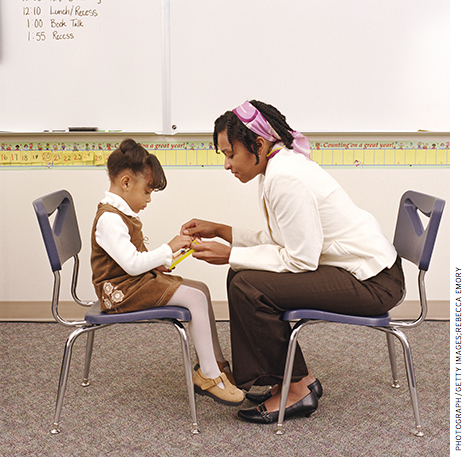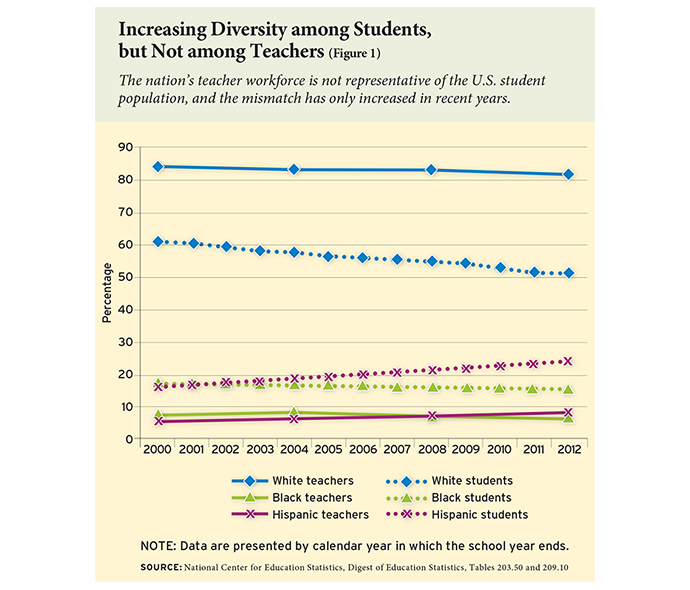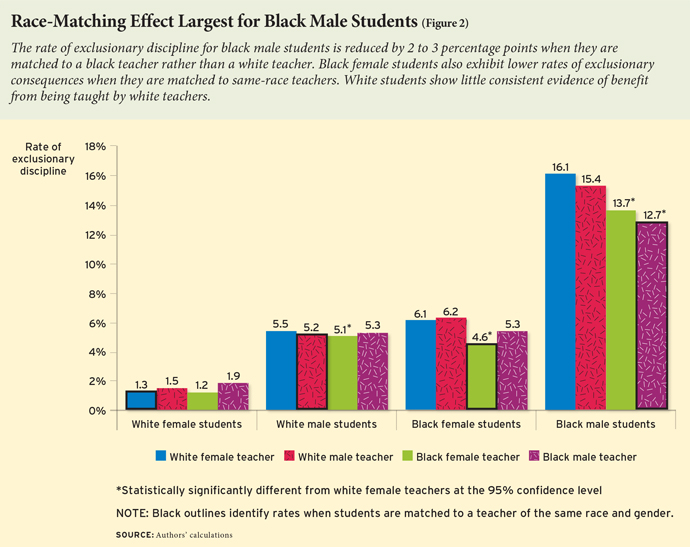Across the United States, black and Latino students are far more likely than their white classmates to be removed from school as punishment. These disparities have led to widespread concern about a potential “school-to-prison pipeline,” in which detentions, suspensions, and expulsions ultimately lead to the overrepresentation of people of color in the nation’s prisons.
 Breaking the pipeline is an explicit federal priority, and on the campaign trail, Hillary Clinton pledged $2 billion to help schools add counselors and reduce suspensions. “This is not just an education issue, this is a civil rights issue, and we cannot ignore it any longer,” she told a Harlem audience in February 2016.
Breaking the pipeline is an explicit federal priority, and on the campaign trail, Hillary Clinton pledged $2 billion to help schools add counselors and reduce suspensions. “This is not just an education issue, this is a civil rights issue, and we cannot ignore it any longer,” she told a Harlem audience in February 2016.
But while much has been said about the potential negative effects of exclusionary school punishment, little is known about what policymakers can do to address it. By contrast, researchers have devoted considerable attention to studying racial disparities in educational opportunities and outcomes—and there is compelling evidence that when students have a teacher of the same race, they tend to learn more at school (see “The Race Connection,” research, Spring 2004).
Those findings raise a parallel question: Does having a teacher of the same race make it more or less likely that students are subject to exclusionary school discipline?
In this study, we analyze a unique set of student and teacher demographic and discipline data from North Carolina elementary schools to examine whether being matched to a same-race teacher affects the rate at which students receive detentions, are suspended, or are expelled. The data follow individual students over several years, enabling us to compare the disciplinary outcomes of students in years when they had a same-race teacher and in years when they did not.
We find consistent evidence that North Carolina students are less likely to be removed from school as punishment when they and their teachers are the same race. This effect is driven almost entirely by black students, especially black boys, who are markedly less likely to be subjected to exclusionary discipline when taught by black teachers. There is little evidence of any benefit for white students of being matched with white teachers.
Although these results are based on a single state, they should encourage efforts to promote greater diversity in the teaching workforce, which remains overwhelmingly white. In addition to offering more diverse role models at the front of the class, our findings suggest that employing more teachers of color could help minimize the chances that students
of color, who trail their white peers in academic achievement, are also subjected to discipline that removes them from school.
A “Pipeline” Problem
The theory behind the “school-to-prison pipeline” concept is that black and Latino students experience harsher discipline in school than their white peers, and that these school-based experiences increase the likelihood of their eventual engagement with the criminal justice system. Indeed, a 2014 analysis of school discipline data by the U.S. Commission on Civil Rights found these students are overrepresented among students who experience exclusionary discipline across the country. Black children, for example, represented 16 percent of K‒12 enrollment nationwide but were 43 percent of students who received multiple out-of-school suspensions during the 2011‒12 school year (see “What Do We Know about School Discipline Reform?” features, Winter 2017).

are the potential first steps in the “school-to- prison pipeline.”
Could the lack of diversity in the teaching force contribute to these disparities? In theory, teachers’ race could influence whether students experience exclusionary discipline in several ways. It could be preventative: students could have better rapport with same-race teachers, and be less likely to act up in their classes in the first place. Or, regardless of student behavior, teachers might be more inclined to be lenient to students of their same race.
In fact, a handful of studies have shown that black and Latino students are less likely to receive exclusionary discipline in schools with higher concentrations of black and Latino teachers. But these previous studies looked at aggregate relationships at the school level; therefore, we cannot rule out the possibility that schools with more teachers of color have different disciplinary practices for reasons unrelated to teacher demographics.
Separating out the effect of race matching from differences between schools requires individual-level data on students and teachers, including their race and exposure to school discipline measures over multiple years. Only with that information is it possible to examine whether discipline rates vary for individual students based on whether they are placed with a teacher of the same race.

North Carolina in Focus
The nation’s current teacher workforce is not representative of the majority non-white U.S. student population, and the mismatch has only increased in recent years (Figure 1). North Carolina reflects these national trends: from 2001 to 2013, the share of black or Latino teachers in North Carolina declined slightly from 16 to 15 percent, while the percentage of black or Latino students rose from 37 to 41 percent.
The state’s ongoing data-collection efforts have created a robust data set that allows us to study the effects of a student-teacher demographic match. Since 2008, North Carolina has collected detailed disciplinary records for all public school students, including the type of offense and disciplinary consequences. In addition, the state collects demographic data from both students and teachers, and provides identifiers that allow researchers to link students to their classroom teachers.
We focus on students in 1st through 5th grades. Since these elementary school students spend the bulk of their day in a single teacher’s classroom, this approach allows us to isolate whether a student was exposed to a same-race teacher. We also limited our sample to white students and black students, which are the two largest racial groups in North Carolina and account for 78 percent of the total observations in the data. Students of other racial and ethnic groups had insufficient exposure to same-race teachers for the purposes of our study. For example, while Latino students account for 16 percent of observations in the data, the state has too few Latino teachers to estimate precise race-match effects for this group.
The resulting sample includes roughly one million students and 50,000 teachers, from the years 2008 through 2013. In 2013, the most recent year of our data, one-third of students were black and two-thirds were white. Ten percent of these students were taught by a black teacher and 88 percent were taught by a white teacher.
Our primary outcome of interest is whether a student received an exclusionary disciplinary consequence—that is, one that removed him or her from the classroom as punishment, including detention, in-school suspension, out-of-school suspension, or expulsion. Overall, 7 percent of students in our data received an exclusionary disciplinary consequence.
Isolating Race-Match Effects
To isolate the effects of having a teacher of the same race, we examine whether individual students are more or less likely to face exclusionary disciplinary consequences in years when they are matched to a same-race teacher compared to years when they are assigned to a teacher of a different race. Comparing students to themselves over time effectively controls for all student characteristics that do not change over time and could lead to differences in disciplinary outcomes.
When making these comparisons, we also take into account student, teacher, and school characteristics that do change over time. These include students’ grade level, Limited English Proficiency status and eligibility for subsidized school meals, their teachers’ years of experience in North Carolina public schools, class size, school size, schools’ racial and socioeconomic makeup, and schools’ average math and reading scores on statewide tests.
Of course, race is not the only aspect of the match between students and teachers that could influence disciplinary outcomes; gender could also matter. And the benefits of having a demographically matched teacher could vary according to a student’s own race or gender. For example, other researchers have found that race-based disparities in discipline outcomes are especially pronounced for black boys. In addition to looking overall at all students in our sample, we therefore also look separately at race-gender groups: white males, white females, black males, and black females. We estimate the effect for each of these student groups of being assigned to demographically matched teachers.
The Benefits of a Match
We find clear evidence that elementary school students are less likely to be subjected to exclusionary discipline when their race matches that of their teacher. Overall, students matched to a same-race teacher are roughly 1 percentage point less likely to be placed in detention, suspended, or expelled than students assigned to a different-race teacher. To put the size of this effect in context, the overall share of students who received any exclusionary discipline consequences during the study period was 7 percent. Therefore, the effect of teacher-student race match represents a 12 percent decrease in the number of students experiencing exclusionary discipline.
The overall effect of race matching on discipline outcomes is largest for black male students (Figure 2). Sixteen percent of black male elementary school students in the classrooms of white female teachers received exclusionary discipline in North Carolina during our study period. But being assigned to a black female teacher reduces that rate by about 2 percentage points to approximately 14 percent, a 15 percent decrease. Similarly, being assigned to a black male teacher rather than a white male teacher reduces exclusionary discipline rates from 15 to 13 percent, a reduction of about 18 percent.

Black female students also experience lower rates of exclusionary consequences when exposed to same-race teachers, although the effect of 1 to 2 percentage points (15 to 25 percent) is only statistically significant when they are taught by black female teachers.
For both black boys and black girls, the effect of a same-race teacher (comparing teachers of the same gender) is larger than the effect of a same-gender teacher (comparing teachers of the same race). But for white students, neither teacher sex nor race has any consistent effect on exclusionary discipline rates. Figure 2 also shows the large differences in exclusionary discipline rates between black students and white students, a gap that remains substantial regardless of the race and gender of the teacher. Even for black boys, having a same-race teacher only closes about one-quarter of the race gap.
The impact of having a same-race teacher on black students’ discipline rates is consistently negative across all of the outcomes we examine, including detention, in-school suspension, out-of-school suspension, and the overall number of disciplinary incidents. For each outcome, the effect tends to be larger for black boys than for black girls.
These results hold up even as we perform a number of tests of their validity. For example, one could imagine that a principal may consciously assign a child who had several disciplinary incidents in his 1st-grade year to a demographically similar teacher for 2nd grade, in hopes of finding a better fit for the child. This type of behavior could exaggerate the race-matching effects we find. However, we find no evidence that students’ disciplinary outcomes are systematically related to whether they are assigned to a same-race teacher in future years. Additionally, we find a similar pattern of race-matching effects when we exclude students who received exclusionary discipline penalties in the prior year.
Do Matches Matter Everywhere?
We examine whether race-match effects vary based on a range of other student and school characteristics. We see no consistent evidence that benefits vary across grade levels, rural or urban school settings, or at magnet programs. At charter schools, however, race matching appears unrelated to student discipline across all groups, suggesting that discipline dynamics may have been different in charters than in traditional public schools during the period we studied.

We also divide up schools based on their proportion of black students to compare race-match benefits at schools where less than one-third, one- to two-thirds, or more than two-thirds of students were black. The benefits for black students are most pronounced at schools where at least one-third of students were black.
However, because schools with larger populations of black students have higher average exclusionary discipline rates overall, race-matched students at those schools are not necessarily less likely to experience such measures. On average, a black student with a black teacher in a school where more than two-thirds of the student-body is black is still more likely to experience exclusionary discipline, compared to a black student assigned to a white teacher in a school where black students accounted for less than a third of the student population.
Student economic status has varying relationships with race-match effects. Black students benefit from race-matched teachers regardless of whether they qualify for subsidized school meals, though the advantage is somewhat larger for less affluent students. Interestingly, low-income white boys have a higher rate of exclusionary discipline when matched to white teachers relative to non-white teachers. Although we cannot test specific mechanisms with our data, the reduced rates of exclusionary discipline with black teachers across the board may suggest that part of the same-race effect we have documented may stem from teachers and students being more likely to share the same socioeconomic background.
Our data also allow us to examine the impact of race matching on student performance on standardized math and reading tests. Earlier research suggests that same-race teachers are beneficial for student achievement. If the opposite pattern were to hold in North Carolina, however, it would suggest a tradeoff between improving disciplinary and academic outcomes.
We find that black students in North Carolina do better on reading tests when matched with same-race teachers (by about 3 percent of a standard deviation), but there are no differences in their math performance. Conversely, white students do better on math tests when matched to a same-race teacher (by roughly 2 percent of a standard deviation), but do not perform better in reading. These patterns suggest that increasing exposure to black teachers is beneficial at best and neutral at worst for all students in terms of discipline, and that increasing teacher diversity while keeping teacher quality constant would have a modest positive effect on the reading achievement of black students while having an opposite effect on the math achievement of white students.
Implications
If reducing children’s exposure to school removal as punishment is a national priority, then our study points to one potentially effective strategy: increasing the number of teachers of color in public schools. We find clear evidence that exposure to black teachers can reduce the likelihood of black students being subject to exclusionary disciplinary consequences, and increase their reading achievement.
We do not observe any advantages of teacher-student race match for white children in terms of their discipline outcomes, although we do find a small positive impact on math achievement. This suggests that the recruitment and retention of a greater number of black teachers could support the positive development of black children. This goal is particularly pressing given the persistent race-based disparities not only in school discipline outcomes, but also in terms of academic achievement and measures of adult well-being and success.
We don’t yet know why black students are less likely to be suspended or expelled from school when they are taught by a black teacher. It is possible that biases based on assumptions about race influence teachers’ and students’ behavior. Black teachers may be more lenient toward same-race students, and white teachers might be less lenient toward students of a different race. Perhaps black students are inclined to behave better for black teachers.
It may also be that black teachers simply have more effective classroom-management practices than white teachers, on average, and are therefore better able to induce misbehaving students to exhibit better behavior. Further research on the differences between the classroom management strategies deployed by black teachers and by white teachers would shed light on these mechanisms, and might provide useful classroom management lessons for all teachers.
Regardless, our findings provide yet another compelling rationale to diversify the teaching workforce. Cultivating a teaching workforce that is reflective of an increasingly diverse student body reflects inclusive national values, and may serve as a critical tool to narrow the racial gap in discipline outcomes.
Constance A. Lindsay is currently a Professorial Lecturer in the School of Public Affairs at American University. Cassandra M. D. Hart is assistant professor of education policy at the University of California, Davis, School of Education.
This article appeared in the Winter 2017 issue of Education Next. Suggested citation format:
Lindsay, C.A., and Hart, C.M.D. (2017). Teacher Race and School Discipline: Are students suspended less often when they have a teacher of the same race? Education Next, 17(1), 72-78.


